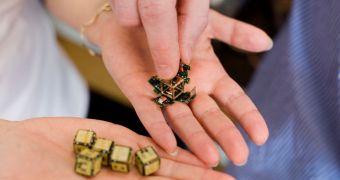Scientists with the Distributed Robotics Laboratory (DRL) at the Massachusetts Institute of Technology (MIT) Computer Science and Artificial Intelligence Laboratory (CSAIL) announce the development of algorithms that could enable the creation of smart sand.
The material could be used to create reconfigurable robots, among many other practical applications. Details of the work will be presented this May, at the IEEE International Conference on Robotics and Automation, the most prestigious meeting in the field of robotics.
During the presentation, the team will also describe a series of experiments they carried out using these algorithms, conducted on large structure. Cubes measuring up to 10 millimeters on each edge were outfitted with simple microprocessors and wired magnets on four of their sides.
DRL experts say that the main difference between smart sand and other approaches to creating reconfigurable robots is the fact that the former is a subtractive method, not an additive one. This means that it focuses on removing material from robots, rather than adding it.
The additive method can best be described by comparing it to building something out of LEGO blocks. The subtractive method is more like carving something out of a rough block of stone, removing material in order to reveal the final structure.
Each individual grain in the smart sand will have the ability to communicate with the others, in order to determine whether it is needed for assembling a certain 3D structure. If this is not the case, then the unnecessary grains would simply disconnect and fall off.
The main challenge here was developing smart algorithms that require very few computational resources. The work was led by MIT professor of computer science and engineering Daniela Rus.
“How do you develop efficient algorithms that do not waste any information at the level of communication and at the level of storage?” she says. One approach would be to store a digital map of the target object within each smart sand grain, the expert adds, but this is not the best way.
The approach the team opted for instead relies on allowing each individual block to identify its position in respect to both the boundaries of the workspace and the limits of the object being replicated. Each grain identifies its position in respect to the other, and only those that are needed remain in the structure.
[YOUTUBE=http://www.youtube.com/watch?feature=player_embedded&v=okciiW26A6c]

 14 DAY TRIAL //
14 DAY TRIAL //